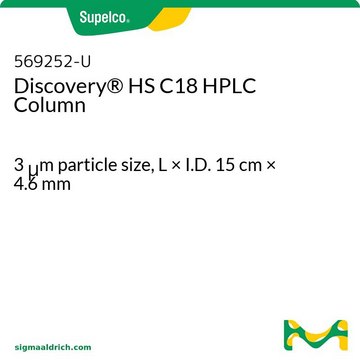Wichtige Dokumente
569426-U
Discovery® C8 (5 µm) HPLC Columns
L × I.D. 12.5 cm × 4 mm, HPLC Column
About This Item
Empfohlene Produkte
Produktbezeichnung
HPLC-Säule Discovery® C8, 5 μm particle size, L × I.D. 12.5 cm × 4 mm
Materialien
stainless steel column
Qualitätsniveau
Agentur
suitable for USP L7
Produktlinie
Discovery®
Leistungsmerkmale
endcapped
Hersteller/Markenname
Discovery®
Verpackung
1 ea of
Kennzeichnungsgrad
7.5% Carbon loading
Parameter
≤70 °C temp. range
400 bar pressure (5801 psi)
Methode(n)
HPLC: suitable
LC/MS: suitable
L × ID
12.5 cm × 4 mm
Oberflächenbereich
200 m2/g
Oberflächendeckung
3.4 μmol/m2
Verunreinigungen
<10 ppm metals
Matrix
silica gel, high purity, spherical base material
fully porous particle
Aktive Matrixgruppe
C8 (octyl) phase
Partikelgröße
5 μm
Porengröße
180 Å
pH Betriebsbereich
2-8
Anwendung(en)
food and beverages
Trenntechnik
reversed phase
Suchen Sie nach ähnlichen Produkten? Aufrufen Leitfaden zum Produktvergleich
Verwandte Kategorien
Leistungsmerkmale und Vorteile
- Ausgezeichnete Reproduzierbarkeit
- Schnellere Trennung von stark hydrophoben Analyten als bei C18-Säulen
- Stabile, gering blutende LC-MS-Trennungen
- Hervorragende Peakformen bei basischen und sauren Analyten
- Kompatibel mit schwach organischen/hochwässrigen mobilen Phasen
Rechtliche Hinweise
Vorsäulenkartusche
Ähnliches Produkt
Hier finden Sie alle aktuellen Versionen:
Besitzen Sie dieses Produkt bereits?
In der Dokumentenbibliothek finden Sie die Dokumentation zu den Produkten, die Sie kürzlich erworben haben.
Verwandter Inhalt
Discovery C18 and C8 HPLC Columns products offered
Global Trade Item Number
| SKU | GTIN |
|---|---|
| 569426-U | 4061833301067 |
| 740683-1G | 4061832884394 |
Unser Team von Wissenschaftlern verfügt über Erfahrung in allen Forschungsbereichen einschließlich Life Science, Materialwissenschaften, chemischer Synthese, Chromatographie, Analytik und vielen mehr..
Setzen Sie sich mit dem technischen Dienst in Verbindung.





